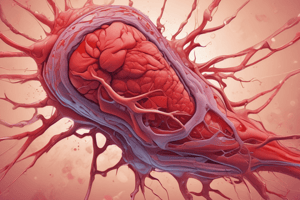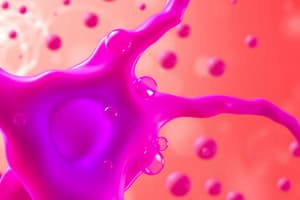Podcast
Questions and Answers
What is the role of tissue plasminogen activator (tPA) in clot management?
What is the role of tissue plasminogen activator (tPA) in clot management?
- It induces platelet aggregation.
- It activates plasminogen to plasmin. (correct)
- It promotes thrombin generation.
- It converts fibrin into fibrinogen.
What are the small fragments produced from the breakdown of fibrin called?
What are the small fragments produced from the breakdown of fibrin called?
- Plasminogen
- Thrombin
- Prothrombin
- D-dimers (correct)
How does antithrombin III function in the coagulation process?
How does antithrombin III function in the coagulation process?
- It enhances platelet activation.
- It converts fibrin into fibrinogen.
- It promotes the production of tissue factor.
- It acts as an inhibitor of thrombin and certain clotting factors. (correct)
Why do we not experience constant clotting in the body?
Why do we not experience constant clotting in the body?
Which enzyme is responsible for cleaving fibrinogen into fibrin during the coagulation cascade?
Which enzyme is responsible for cleaving fibrinogen into fibrin during the coagulation cascade?
What is the primary pharmacological treatment used after a thrombotic stroke?
What is the primary pharmacological treatment used after a thrombotic stroke?
During haemostasis, what role do nitric oxide and prostacyclin play?
During haemostasis, what role do nitric oxide and prostacyclin play?
What happens to the clot once the injury is healed?
What happens to the clot once the injury is healed?
What is the primary function of secondary haemostasis?
What is the primary function of secondary haemostasis?
Which coagulation factors are dependent on Vitamin K for their synthesis?
Which coagulation factors are dependent on Vitamin K for their synthesis?
What occurs first in the secondary haemostasis process?
What occurs first in the secondary haemostasis process?
Which of the following statements about proenzymes is true?
Which of the following statements about proenzymes is true?
What is the active form of a coagulation factor denoted by?
What is the active form of a coagulation factor denoted by?
Which stage is NOT included in the secondary haemostasis process?
Which stage is NOT included in the secondary haemostasis process?
Which pathway does NOT belong to the coagulation cascade?
Which pathway does NOT belong to the coagulation cascade?
What role do activated platelets play in secondary haemostasis?
What role do activated platelets play in secondary haemostasis?
What initiates the extrinsic pathway of blood clotting?
What initiates the extrinsic pathway of blood clotting?
Which component is activated first in the intrinsic pathway?
Which component is activated first in the intrinsic pathway?
What is the primary role of the tissue factor (TF) in the extrinsic pathway?
What is the primary role of the tissue factor (TF) in the extrinsic pathway?
Which ion is crucial for the activation of the common pathway in coagulation?
Which ion is crucial for the activation of the common pathway in coagulation?
Which of the following statements about the common pathway is accurate?
Which of the following statements about the common pathway is accurate?
Which cell types are primarily involved in the initiation of the extrinsic pathway?
Which cell types are primarily involved in the initiation of the extrinsic pathway?
How is FXII activated in the intrinsic pathway?
How is FXII activated in the intrinsic pathway?
What is the function of the intrinsic pathway in hemostasis?
What is the function of the intrinsic pathway in hemostasis?
Which of the following factors is involved in the formation of the intrinsic tenase complex?
Which of the following factors is involved in the formation of the intrinsic tenase complex?
Which process is linked to primary hemostasis in the context of the intrinsic pathway?
Which process is linked to primary hemostasis in the context of the intrinsic pathway?
Flashcards
Haemostasis
Haemostasis
The process where the body forms a blood clot to stop bleeding.
Primary Haemostasis
Primary Haemostasis
The initial phase of haemostasis, involving platelets adhering to the damaged vessel wall and forming a loose plug.
Secondary Haemostasis
Secondary Haemostasis
The second phase of haemostasis, involving a series of enzymatic reactions to produce fibrin and strengthen the platelet plug.
Coagulation Factors
Coagulation Factors
Signup and view all the flashcards
Proenzyme (Zymogen)
Proenzyme (Zymogen)
Signup and view all the flashcards
Activated Coagulation Factor ('a')
Activated Coagulation Factor ('a')
Signup and view all the flashcards
Extrinsic Pathway
Extrinsic Pathway
Signup and view all the flashcards
Intrinsic Pathway
Intrinsic Pathway
Signup and view all the flashcards
Coagulation Cascade
Coagulation Cascade
Signup and view all the flashcards
Thrombin (FIIa)
Thrombin (FIIa)
Signup and view all the flashcards
Fibrinolysis
Fibrinolysis
Signup and view all the flashcards
Plasmin
Plasmin
Signup and view all the flashcards
Tissue Factor Pathway Inhibitor (TFPI)
Tissue Factor Pathway Inhibitor (TFPI)
Signup and view all the flashcards
Antithrombin III
Antithrombin III
Signup and view all the flashcards
Tissue Factor (TF)
Tissue Factor (TF)
Signup and view all the flashcards
Factor VII (FVII)
Factor VII (FVII)
Signup and view all the flashcards
Extrinsic Tenase Complex
Extrinsic Tenase Complex
Signup and view all the flashcards
Factor XII (FXII)
Factor XII (FXII)
Signup and view all the flashcards
Factor XI (FXI)
Factor XI (FXI)
Signup and view all the flashcards
Factor IX (FIX)
Factor IX (FIX)
Signup and view all the flashcards
Common Pathway
Common Pathway
Signup and view all the flashcards
Factor X (FX)
Factor X (FX)
Signup and view all the flashcards
Study Notes
Haemostasis - Part II: Secondary Haemostasis
- Secondary haemostasis is a crucial part of the overall haemostatic process, following primary haemostasis.
- It involves a cascade of events to strengthen the platelet plug formed during primary haemostasis.
- The aim is to create a stable blood clot.
Preparation
- Students need to have completed the previous lecture on Haemostasis Part I to understand secondary haemostasis.
- Students should write out the pathways in a way that makes sense to them.
Aims and Objectives
- Students will be able to outline the processes of normal haemostasis.
- They will be able to explain the importance of effective haemostasis.
- They will be able to describe the major components of haemostatic mechanisms.
- They will be able to describe the mechanisms of secondary haemostasis.
Primary and Secondary Haemostasis
- Primary haemostasis: involves platelet response to vessel wall injury, platelet adhesion, and formation of a primary platelet plug.
- Secondary haemostasis: involves activation of the intrinsic and extrinsic coagulation pathways, activation of the common pathway, and fibrin strand formation strengthening the platelet plug.
Secondary Haemostasis
- A weak platelet plug requires strengthening by coagulation factors.
- Coagulation factors mainly comprise proenzymes, or zymogens.
- Most coagulation factors are synthesised in the liver.
- Factors II, VII, IX, and X are vitamin K-dependent.
- Proenzymes need activation to function. The active form of a coagulation factor is denoted by 'a'.
Secondary Haemostasis - 4 Stage Process
- Stage 1: Tissue factor is expressed or released.
- Stage 2: Activated platelets express phospholipid complexes, which provide binding sites for coagulation factors to become activated.
- Stage 3: Prothrombin is converted to thrombin.
- Stage 4: Fibrinogen is converted to fibrin, which strengthens the clot.
The Coagulation Cascade
- The coagulation cascade consists of three pathways: intrinsic, extrinsic, and common pathways.
Extrinsic Pathway
- Initiated by vascular injury.
- Tissue factor (TF) is exposed, binding to FVII to form FVIIa.
- FVIIa activates factor X forming factor Xa.
Intrinsic Pathway
- Initiated by contact with negatively charged surfaces (e.g., collagen, negatively charged phospholipids on platelets).
- This involves a cascade of activation events culminating in the activation of factor X.
Common Pathway
- Both the intrinsic and extrinsic pathways converge at the common pathway.
- Factor X is activated by either pathway (Xa).
- Xa along with other factors forms the prothrombinase complex.
- The prothrombinase complex converts prothrombin to thrombin.
- Thrombin cleaves fibrinogen to form fibrin, which polymerizes to form the blood clot.
What Happens to the Clot Afterwards?
- When the injury is healed, the clot is broken down by fibrinolysis.
- Tissue plasminogen activator (tPA) is an enzyme that converts plasminogen to plasmin.
- Plasmin then digests fibrin, producing small fragments known as d-dimer.
- Recombinant tPA and plasminogen activators are pharmacological treatments for thrombotic stroke.
Why Don't We Get Clots All The Time?
- Haemostasis is tightly controlled by both intrinsic and extrinsic pathways.
- Endogenous inhibitors of primary haemostasis include nitric oxide and prostacyclin (PGI2) produced in endothelial cells.
- Endogenous inhibitors of secondary haemostasis include:
- Tissue factor pathway inhibitor (TFPI)
- Antithrombin III
- Protein C
- These inhibitors prevent unnecessary clot formation.
Studying That Suits You
Use AI to generate personalized quizzes and flashcards to suit your learning preferences.
Related Documents
Description
This quiz focuses on Secondary Haemostasis, which is essential for strengthening the platelet plug formed during primary haemostasis. Students will explore the processes that contribute to normal haemostasis, its importance, and the mechanisms involved in secondary haemostasis. Ensure you have completed Haemostasis Part I for better comprehension.




